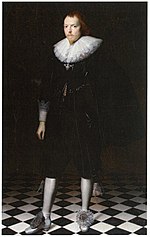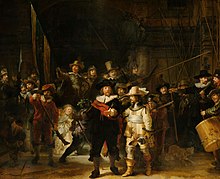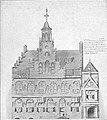Frans Banninck Cocq

Frans Banninck Cocq , also incorrectly written Frans Banning (h) Cocq or Frans Benning (h) Cocq (* February 23, 1605 in Amsterdam ; † January 1, 1655 ibid), Knight of Saint Michael , Army of Purmerland and Ilpendam ( Iure uxoris ), was an Amsterdam ruler of the Golden Age . He became known for his portrayal as Captain of the Night Watch by Rembrandt van Rijn .
origin

In the Amsterdam upper class, there were two families with very similar names, the Banning (h) or Benning (h) family and the Banninck family, who were not closely related. The first-mentioned family was of greater importance, they provided members of the city government earlier and for a longer period of time. Frans Banninck Cocq belonged to the less important family. Due to the similar names, there were already misspellings among contemporaries, for example Banninck Cocq appears on the name tag of the night watch that was subsequently painted on around 1653 as Frans Banning Cocq / heer van Purmerlant en Ilpendam / Capiteijn . He himself signed Banninck Cocq and his university diploma calls him Franciscus Bannink in 1626 . A two-part family album created by Banninck Cocq contains a copy of the Night Watch as well as numerous drawings and watercolors, including family coats of arms. For a long time it was assumed that Frans Banninck Cocq himself had manipulated the family albums in such a way that they proved his origin from the older patrician family. In fact, the forgeries were made in the handwriting of his nephew Pieter de Graeff , who had lost all municipal offices after the Rampjaar and later inherited the title of Lord of Purmerland and Ilpendam. The painter Jacob Colijns , who may also have painted the copy of the Night Watch in the family album, and the poet Joost van den Vondel supported him in manipulating his family history . The Dutch writer Johan Engelbert Elias published his two-volume history of the Amsterdam city administration from 1578 to 1795 from 1903 to 1905. He did not see through de Graeff's forgeries and merged both families into one, but this refuted in the 21st century by new research and the completely different family coats of arms could be.
Frans Banninck Cocq was born on February 23, 1605 in the Sint Antoniesbreestraat (then Dijkstraat , which is not today's Dijkstraat ) in the east of Amsterdam and was baptized four days later in the Oude Kerk . He was the son of Jan Jansz. Cock (1575–1633), a pharmacist who immigrated from Bremen , and Lijsbeth Fransdr , the patrician daughter of Amsterdam . Banninck (1581-1623). Deviating from the tradition according to which he was the firstborn to receive the name of his paternal grandfather, he received the first and last name of his maternal grandfather, who died in 1582 at the age of 38. In this way, the parents documented the right to continue a family tradition. The Bannincks had been members of the Amsterdam City Council for generations and only Frans Banninck's early death before he could reach high office had broken the tradition.
Life

|

|
|
|
Wedding portraits of Maria Overlander and Frans Banninck Cocq , Wybrand de Geest , 1630, oil on canvas, each 198.5 × 121 cm, Museum Het Prinsenhof , Delft
|
||
The young Frans Banninck Cocq grew up opposite today's Museum Het Rembrandthuis in that part of the Sint Antoniesbreestraat that is later and still called Jodenbreestraat. Overlooking the desired career in city government, he studied at the Poitiers University Law .
On April 23, 1630 he married Maria Overlander (1603-1678), the heir to the knight and city regent Volkert Overlander (Maria's sister Geertruid Overlander, 1609-1634, married Cornelis de Graeff ). After the death of his father-in-law, he had the title of one from 1631 Lords of Purmerland and Ilpendam . The couple lived in the 1600 by Hendrick de Keyser for Hendrik Laurensz. Spiegel built and in 1609 Volkert Overlander bought the house De Dolphijn at Singel 140-142 for 14,000 guilders .
In the Amsterdam city administration he held a variety of offices since 1632. In 1632, 1633 and 1636 he became a member of the Commission for Marriage Affairs. In 1634, 1635, 1641, 1643, 1644 and 1650 he was a member of the Commission for Small Affairs ( Commissaris van Kleine zaken ). From 1634 until his death he was a city councilor. In 1637, 1640, 1642, 1645, 1646, 1648 and 1649 he was elected to the college of aldermen. From 1638 to 1639 he was a member of the commission for the municipal loan office ( Commissaris van de Bank van Leening ). Banninck Cocq was elected mayor from 1650 to 1651 and from 1653 to 1654. In this position he worked closely with his brother-in-law Cornelis de Graeff and his supporter Johan Huydecoper van Maarsseveen . In 1652 he exercised the office of auditor of the city administration and was also trustee of the orphan fund.

In 1635 Banninck Cocq joined the Amsterdam vigilante as a lieutenant in the first district. From about 1639 to 1646 he was captain of the second district, in this capacity he was portrayed by Rembrandt in the night watch . From 1646 to 1650 Banninck Cocq was colonel in the vigilante group, but he had to give up this rank when he was elected mayor. From 1648 to 1654, Banninck Cocq was the governor of Handboogdoelen, the archers 'headquarters, and a member of a four-person management committee that was responsible for the administration of the archers' guild and its fixed and movable assets. In 1648 he was accepted as a knight in the French Ordre de Saint-Michel .
Frans Banninck Cocq died on New Year's Day 1655 and was buried in Amsterdam's Oude Kerk on January 6, 1655.
Family album
Frans Banninck Cocq created a two-volume family album measuring around 19 × 15 centimeters, which essentially consisted of watercolors and colored drawings. In addition to the genealogy of his family, with illustrations of a number of coats of arms, numerous buildings are shown to which Banninck Cocq had a relationship. These included the family seat in Ilperdam, the De Dolphijn house in the Amsterdam Singel 140-142, the Handboogdoelen, of which he was governor, and a drawing of Rembrandt's Night Watch after it was copied by Gerrit Lundens. In historical literature, this family album has long been viewed as evidence of Banninck Cocq's vanity, and the false information about family history has been attributed to him. In fact, Banninck Cocq himself attached great importance to the truthful description of his origin and his living conditions; as one of Amsterdam's leading patricians, he had no reason to whitewash. The family book was certainly not made for the sake of bragging rights, but rather served as an illustrated autobiography for Banninck Cocq. Many of the depictions were probably painted by himself, and the book was completed by himself around 1654. The Night Watch was probably painted by Jacob Colijns on behalf of Banninck Cocqs. A series of handwritten additions were made after Banninck Cocq's death by his nephew Pieter de Graeff , who, in the face of the loss of all public offices after 1672, had reason and opportunity to improve his family history. It is possible that other drawings and watercolors in the family book were only added by Colijns after Banninck Cocq's death, who also forged or falsified documents on other families related to him in de Graeff's favor. The family book is still in the possession of the de Graeff family and is on permanent loan in the Rijksprentenkabinet of the Rijksmuseum Amsterdam.
- Watercolors and drawings from Frans Banninck Cocq's family album
Portraits



The portrait with which Frans Banninck Cocq achieved worldwide fame for centuries is his portrayal as captain of a rifle company on Rembrandt van Rijn's Die Nachtwache . Banninck Cocq was the only one of the paying company members to show his satisfaction with the portrayal. Among the numerous copies of the Night Watch , two are of particular importance in that they were commissioned by Banninck Cocq or painted by himself. The copy in oil on oak, painted by Gerrit Lundens around 1653 , has been on permanent loan from the National Gallery in London in the Rijksmuseum Amsterdam since 1958 . It was commissioned by Banninck Cocq and differs from the original in a number of details, for example the number of pikes is smaller and the course of the stages is different . Since it was made before 1653, the name tag on the archway that was painted on Rembrandt's Night Watch this year is missing . The copy of Lunden is of great art-historical importance because it still reproduces those parts of the painting that were cut off in 1715 and are irretrievably lost. Jacob Colijns probably painted the watercolor in Frans Banninck Cocq's family book after this copy and not the original. It is the 142nd sheet of the first part, and immediately follows a later inserted document dated December 1649. Compared to the original, the watercolor is an even rougher copy.
As early as 1630 Wybrand de Geest painted two life-size pompous portraits as wedding portraits of Maria Overlander and Frans Banninck Cocq . The paintings, executed in oil on canvas, remained in the possession of the de Graeff family in Ilpenstein Castle until it was cleared and demolished in 1872. The two paintings were purchased by a member of the Elias family and remained in the family until the mid-20th century. The couple shown was incorrectly identified as the Amsterdam lawyer Floris Elias (1627-1684) and his wife Debora Pancras († 1668), who had married on May 24, 1650 in Amsterdam. It was only when the paintings reached the Het Prinsenhof Museum in Delft in 2002 that they were examined and identified with Frans Banninck Cocq and Maria Overlander.
At the height of Frans Banninck Cocq's military and political career, as Governor des Handboogsdoelen and Mayor of Amsterdam, he was depicted in a group portrait by Bartholomeus van der Helst . Around 1650 the rifle houses of the longbow, crossbow and musket marksmen lost their function as part of the shooting range. The shooting lanes adjacent to them were built over, including the one behind the handboogsdoelen , which Banninck Cocq and three other men were in charge of. The Doelens now had the function of inns and meeting houses of the rich and powerful rifle guilds, in which celebrations and meetings, but also official receptions were held. Their splendid furnishings with silver dishes and numerous marksmen's pieces and other paintings on the walls documented their outstanding social position. The prerequisite for election to the executive committee was the rank of at least one captain. Since the members were appointed for life and received a share in the Doelens' profits, the seats were very popular, especially among active and former mayors. Between 1653 and 1656 Bartholomeus van der Helst painted three large-format oil paintings with the heads of the three Amsterdam rifle guilds, with which the long tradition of the Amsterdam rifle pieces came to an end. The four rulers of the Longbow or Saint Sebastianus Rifle Guild is shown in the picture The Heads of the Archer's Guild ( De Overlieden van de Handboogdoelen ) painted in 1653 . Frans Banninck Cocq is sitting on the left in the picture with a silver goblet in his hand. The painting and its two counterparts, created in the following years with the heads of the other two guilds, had a representative function. Just as the night watch documented the ability of the Amsterdam citizens to defend themselves, these last marksmen's pieces show the wealth and economic importance of the guilds with the display of precious silver trophies, rifle chains and ceremonial objects.
Further portraits of Frans Banninck Cocq were made after his portrayal on the night watch . An example is a chalk drawing by Jean-Honoré Fragonard in the Musée des Beaux-Arts et d'Archéologie de Besançon from around 1765.
Frans Banninck Cocq Medal
Since 1996, the city of Amsterdam has awarded the Frans Banninck Cocq Medal ( Frans Banninck Cocq Penning ) as an award to residents of Amsterdam who have performed for at least ten years in the cultural, social or economic field that are at least of national importance. The medal was designed by Mirjam Mieras and is made of polished stainless steel. It is awarded in a black box with a portrait of Frans Banninck Cocq printed on the lid. When the can is open, the portrait is reflected in the polished surface of the medal. The marginal inscription gives the name and dates of Banninck Cocqs, on the reverse the name of the recipient and the city of Amsterdam and the date of the award are embossed. The award includes a silver pin with the mirror-inverted initials BC .
Web links
Individual evidence
- ^ SAC Dudok van Heel: Amsterdamse burgemeesters zonder st Bäumen. The poet Vondel en de schilder Colijns vervalsen geschiedenis . In: De zeventiende eeuw 1990, year 6, pp. 144–151.
- ^ Johan Engelbert Elias: De vroedschap van Amsterdam, 1578-1795 . 2 volumes. Haarlem: Vincent Loosjes 1903–1905, Volume 1, pp. 39–45, digitized .
- ^ A b c d e S. AC Dudok van Heel: Frans Banninck Cocq's Troop in Rembrandt's "Night Watch": The Identification of the Guardsmen. In: The Rijksmuseum Bulletin 2009, Volume 57, No. 1, pp. 42-87, JSTOR 40383630 .
- ↑ Remmet van Luttervelt: Het graf van Frans board Banningh Cock . In: Amstelodamum. Maandblad voor de kennis van Amsterdam 1951, Volume 38, pp. 24-26, digitized .
- ↑ Isabella Henriette van Eeghen: De restauratie van Singel 140-142 . In: Amstelodamum. Maandblad voor de kennis van Amsterdam 1967, Volume 54, pp. 88-93, digitized .
- ↑ a b D. C. Meijer: Frans Banning Cocq en zijn family album . In: Eigen Haard 1906, No. 27 of July 7, pp. 426-430, digitized and No. 28 of July 14, pp. 444-447, digitized .
- ↑ a b Anoniem Noordelijke Nederlanden (historical region). Portret van Frans Banningh Cocq (1605-1655) and Anoniem. Portret van Maria Overlander (1603-1678) on the website of the RKD - Nederlands Instituut voor Kunstgeschiedenis , accessed on 19 September 2019.
- ↑ a b Stichting Foundation Rembrandt Research Project (ed.): A Corpus of Rembrandt Paintings. III. 1635-1642. Martinus Nijhoff, Dordrecht, Boston, London 1989, ISBN 978-94-010-6852-9 , Chapter A146 The Night Watch , pp. 430-485.
- ^ Judith van Gent: Bartholomeus van der Helst (circa 1613-1670): een studie naar zijn leven en zijn werk . Zwolle: WBooks 2011, also a dissertation University of Utrecht, ISBN 978-90-400-7805-7 , pp. 61–64 and pp. 303–308, digitized version .
- ↑ Frans Banninck Cocq. 1997 , Mirjam Mieras website, accessed September 19, 2019.
| predecessor | Office | successor |
|---|---|---|
| Geertruid Hooft (widow of Volkert Overlander ) |
Lord of Purmerland and Ilpendam 1637–1655 |
Maria Overlander (widow of Frans Banninck Cocq) |
| personal data | |
|---|---|
| SURNAME | Banninck Cocq, Frans |
| ALTERNATIVE NAMES | Banning Cocq, Frans (frequent misspellings); Banningh Cocq, Frans (frequent misspellings); Banning Kok, Frans (frequent misspellings); Banninck Cock, Frans (alternative spelling); Banninck Kok, Frans (alternative spelling) |
| BRIEF DESCRIPTION | Dutch patrician, Mayor of Amsterdam |
| DATE OF BIRTH | February 23, 1605 |
| PLACE OF BIRTH | Amsterdam |
| DATE OF DEATH | January 1, 1655 |
| Place of death | Amsterdam |




